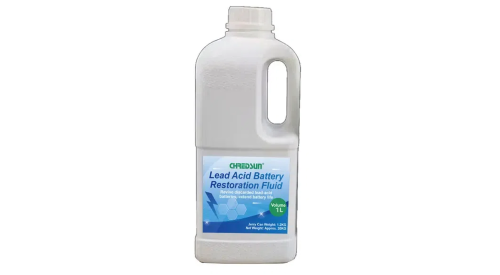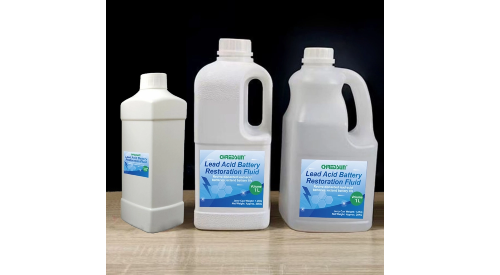
Batteries are the heart of modern portable power—used in everything from cars and motorcycles to backup power systems and industrial machines. Among them, lead-acid batteries are still the most widely used due to their affordability and reliability. However, over time, even these dependable power sources degrade and eventually seem to die, often leading people to discard them.
But what if you could revive dead lead-acid batteries without having to replace them? That’s where battery restore solutions, particularly Lead Acid Battery Restoration Fluid, come into play. These specially formulated fluids offer a cost-effective and eco-friendly way to bring old, sulfated batteries back to life—extending their lifespan and reducing battery waste.
Understanding Battery Degradation
The Structure and Operation of Lead-Acid Batteries
To understand how battery restoration works, it's essential to first grasp how lead-acid batteries function. A typical lead-acid battery consists of the following main components:
Positive and Negative Plates made from lead dioxide (PbO₂) and sponge lead (Pb)
Electrolyte, which is a mixture of water and sulfuric acid (H₂SO₄)
Separators between plates to avoid short circuits
A container to house all components
During discharge, chemical reactions produce electricity as the lead dioxide and sponge lead plates react with sulfuric acid to form lead sulfate (PbSO₄). Upon recharging, the process reverses—at least ideally.
The Problem: Sulfation
Over time, and especially when batteries are deeply discharged or left unused for long periods, sulfation occurs. This means that lead sulfate crystals form and stick to the battery plates. These crystals harden and reduce the ability of the battery to hold and deliver charge.
Sulfation is the primary cause of battery failure in lead-acid systems. Once a battery is heavily sulfated, its internal resistance increases, voltage drops, and its capacity is drastically reduced. That’s when the battery is usually labeled “dead.”
What Is a Battery Restore Solution?
A battery restore solution—or Lead Acid Battery Restoration Fluid—is a chemical additive designed to dissolve hardened lead sulfate crystals and revitalize the electrolyte in sulfated batteries.
Key Components and Their Function
Most battery restoration fluids contain a blend of:
Desulfating agents – to chemically break down lead sulfate crystals
Conductive enhancers – to improve electrolyte conductivity
pH stabilizers – to restore acid balance in the electrolyte
Anti-corrosive agents – to protect plates and extend battery life
These additives work together to recondition the internal chemistry of the battery, enabling it to store and deliver power more efficiently.
Battery Restore Fluid vs. Additives and Charging Alone
It’s important not to confuse a battery restore solution with simple battery additives or just deep recharging. While additives may only mildly improve battery health, and deep charging can sometimes reverse light sulfation, restoration fluids actively reverse the crystallization process, making them far more effective for batteries that seem unusable.
How Lead Acid Battery Restoration Fluid Works
A battery restore solution is more than just a quick fix—it’s a scientifically formulated compound that helps bring dead or degraded lead-acid batteries back to life. This process is especially critical in extending the useful life of batteries used in vehicles, solar systems, backup power systems, and industrial equipment. At the heart of this technology lies the Lead Acid Battery Restoration Fluid, a specialized solution designed to counteract the most common forms of battery degradation.
1. Chemical Reduction of Lead Sulfate Crystals
One of the most vital processes enabled by a battery restore solution is the chemical reduction of lead sulfate crystals (PbSO₄). Over time, when a battery is undercharged or left unused, lead sulfate begins to crystallize and harden on the surface of the lead plates—a condition known as sulfation. This crystalline buildup acts as a barrier, preventing the battery from charging or discharging properly.
The Lead Acid Battery Restoration Fluid contains active compounds that dissolve these hardened crystals and convert them back into lead and sulfuric acid—the active components necessary for the battery’s electrochemical function. As a result, the battery can regain its voltage stability and amp-hour capacity, restoring performance that would otherwise be lost.
2. Cleaning Internal Components
Beyond dissolving sulfate crystals, the restoration fluid also works to clean the internal structure of the battery, especially the lead plates. These plates can accumulate various forms of corrosion and debris over time, which hinders electrical conductivity. The fluid helps break down and remove these contaminants, ensuring smoother electron flow and significantly reducing the battery’s internal resistance.
Lower internal resistance means better efficiency in both charging and discharging cycles. This not only improves the battery's performance but also prevents overheating and energy loss—two common issues in aged or heavily used batteries.
3. Restoring Electrolyte Balance
Another key feature of a high-quality battery restore solution is its ability to restore or stabilize the electrolyte composition inside the battery. In most lead-acid batteries, the electrolyte is a mix of water and sulfuric acid. Over time, improper use or evaporation can dilute the sulfuric acid concentration, weakening the battery’s ability to hold a charge.
Some Lead Acid Battery Restoration Fluids contain additives that help re-acidify the electrolyte or adjust its chemical balance back to optimal levels. This ensures the battery maintains the correct voltage range and chemical equilibrium, helping to prolong its service life and improve overall reliability.
4. Enhancing Plate Reactivity
Lastly, a powerful benefit of using a battery restore solution is its impact on plate reactivity. As sulfation and corrosion accumulate, the surface area of the lead plates becomes less effective in facilitating electrochemical reactions. The restoration fluid not only cleans but also reactivates the surface of these plates, allowing for more efficient ion exchange and faster charge/discharge cycles.
This leads to noticeable improvements in performance—such as shorter charging times, increased power output, and more consistent voltage regulation.

Applications
1. Household Use
Many homeowners use lead-acid batteries for backup power systems (like UPS units), solar panel storage, or lawn equipment. Applying Lead Acid Battery Restoration Fluid can give these batteries a second life, saving the cost of frequent replacements.
2. Automotive Use
Car batteries are prone to sulfation, especially in vehicles that sit idle for long periods. A single treatment with a battery restore solution can bring dead car batteries back to life, avoiding the need for a new purchase.
3. UPS and Emergency Systems
In corporate or industrial settings, Uninterruptible Power Supplies (UPS) rely heavily on lead-acid batteries. Rather than replacing dozens of backup units every few years, businesses can significantly cut maintenance costs using battery restoration fluids to extend battery service cycles.
4. Forklifts and Industrial Equipment
Electric forklifts and other heavy machinery often use large-scale lead-acid batteries. Restoring them with a battery fluid treatment can improve uptime and reduce operational downtime caused by battery issues.
Before and After Comparison
Below is a simplified performance comparison of a lead-acid battery before and after treatment with battery restoration liquid:
Parameter | Before Restoration | After Restoration |
Voltage (Open Circuit) | 10.5V | 12.4V |
Capacity (%) | 30% | 85% |
Internal Resistance | High | Low |
Charge Holding Time | Short | Extended |
These improvements translate to real-world usability—meaning the battery can once again start engines, power tools, or provide emergency backup as intended.
Environmental and Economic Benefits
The most overlooked benefit of battery restore solutions is their contribution to sustainability.
Reduce Toxic Waste: Fewer batteries end up in landfills
Lower Carbon Footprint: Less demand for new battery manufacturing
Cost Savings: One bottle of Lead Acid Battery Restoration Fluid can restore multiple batteries at a fraction of replacement cost
By recycling energy storage through chemical reactivation, these solutions align with green energy initiatives and responsible resource management.
Conclusion
The next time your battery seems dead or unusable, consider using a battery restore solution before replacing it. Lead Acid Battery Restoration Fluids are scientifically formulated to dissolve sulfation, boost battery performance, and extend service life—offering a smart, eco-friendly alternative to disposal. Whether you’re a car owner, solar system user, or work in industrial maintenance, these solutions can save you money and reduce battery waste.
To learn more about reliable and effective battery restoration products, we recommend exploring RedSun Group—a trusted provider of high-performance battery restore solutions. Visit RedSun Group at Website www.chredsun.com or contact their team to find the right solution for your needs and bring your batteries back to life.
English
العربية
Français
Русский
Español
Português
Deutsch
italiano
日本語
한국어
Nederlands
Tiếng Việt
ไทย
Polski
Türkçe
አማርኛ
ພາສາລາວ
ភាសាខ្មែរ
Bahasa Melayu
ဗမာစာ
தமிழ்
Filipino
Bahasa Indonesia
magyar
Română
Čeština
Монгол
қазақ
Српски
हिन्दी
فارسی
Kiswahili
Slovenčina
Slovenščina
Norsk
Svenska
українська
Ελληνικά
Suomi
Հայերեն
עברית
اردو
Afrikaans
Gaeilge
नेपाली
Aymara
Беларуская мова
guarani
Krio we dɛn kɔl Krio
Runasimi
Wikang Tagalog













